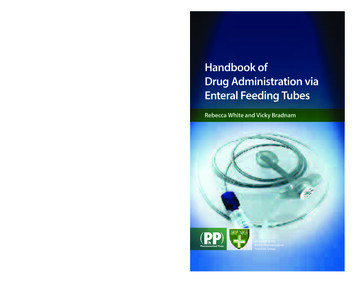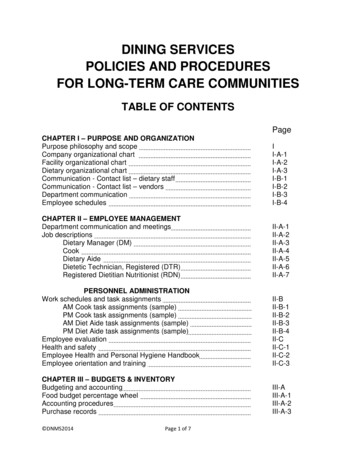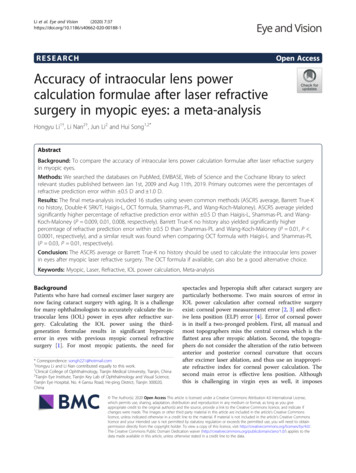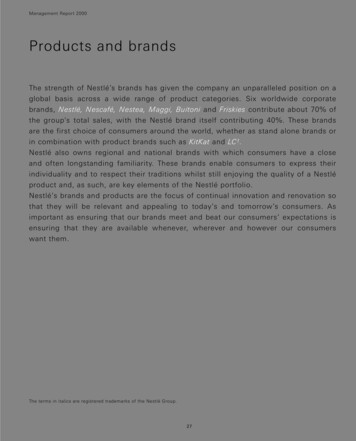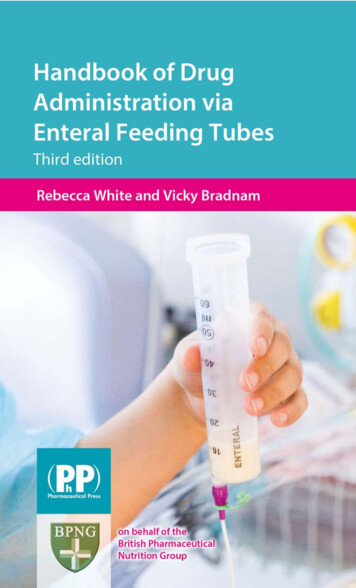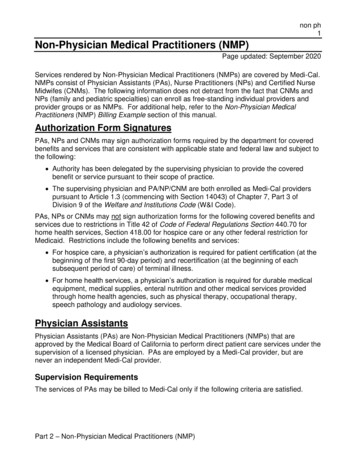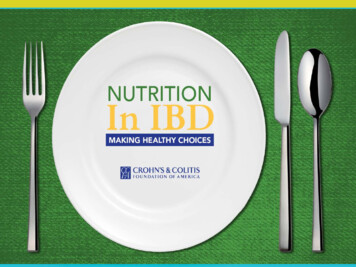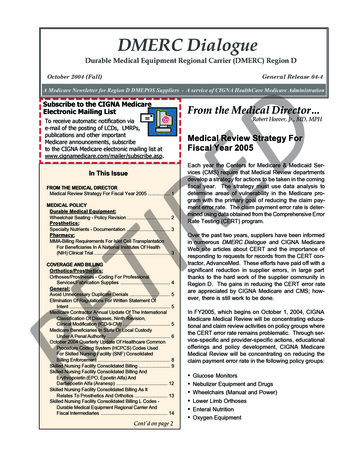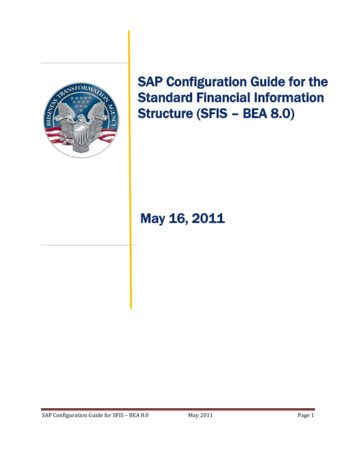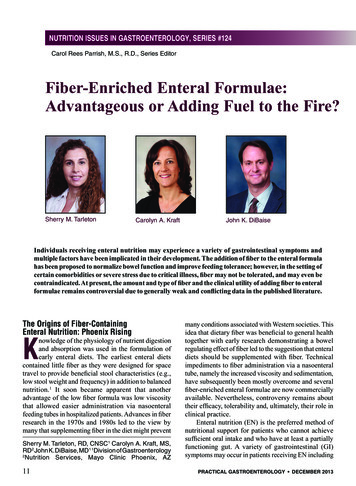
Transcription
NUTRITION ISSUES IN GASTROENTEROLOGY, SERIES #124Carol Rees Parrish, M.S., R.D., Series EditorFiber-Enriched Enteral Formulae:Advantageous or Adding Fuel to the Fire?Sherry M. TarletonCarolyn A. KraftJohn K. DiBaiseIndividuals receiving enteral nutrition may experience a variety of gastrointestinal symptoms andmultiple factors have been implicated in their development. The addition of fiber to the enteral formulahas been proposed to normalize bowel function and improve feeding tolerance; however, in the setting ofcertain comorbidities or severe stress due to critical illness, fiber may not be tolerated, and may even becontraindicated. At present, the amount and type of fiber and the clinical utility of adding fiber to enteralformulae remains controversial due to generally weak and conflicting data in the published literature.The Origins of Fiber-ContainingEnteral Nutrition: Phoenix RisingKnowledge of the physiology of nutrient digestionand absorption was used in the formulation ofearly enteral diets. The earliest enteral dietscontained little fiber as they were designed for spacetravel to provide beneficial stool characteristics (e.g.,low stool weight and frequency) in addition to balancednutrition.1 It soon became apparent that anotheradvantage of the low fiber formula was low viscositythat allowed easier administration via nasoenteralfeeding tubes in hospitalized patients. Advances in fiberresearch in the 1970s and 1980s led to the view bymany that supplementing fiber in the diet might preventSherry M. Tarleton, RD, CNSC1 Carolyn A. Kraft, MS,RD2 John K. DiBaise, MD1 1Division of Gastroenterology2Nutrition Services, Mayo Clinic Phoenix, AZ11many conditions associated with Western societies. Thisidea that dietary fiber was beneficial to general healthtogether with early research demonstrating a bowelregulating effect of fiber led to the suggestion that enteraldiets should be supplemented with fiber. Technicalimpediments to fiber administration via a nasoenteraltube, namely the increased viscosity and sedimentation,have subsequently been mostly overcome and severalfiber-enriched enteral formulae are now commerciallyavailable. Nevertheless, controversy remains abouttheir efficacy, tolerability and, ultimately, their role inclinical practice.Enteral nutrition (EN) is the preferred method ofnutritional support for patients who cannot achievesufficient oral intake and who have at least a partiallyfunctioning gut. A variety of gastrointestinal (GI)symptoms may occur in patients receiving EN includingPRACTICAL GASTROENTEROLOGY DECEMBER 2013
Fiber-Enriched Enteral FormulaeNUTRITION ISSUES IN GASTROENTEROLOGY, SERIES #124diarrhea, constipation, nausea, vomiting and bloating.Multiple factors may contribute to the development ofthese symptoms including concomitant medications,bowel anatomy, underlying comorbidities, changesin gut microbiota, hydration status, administrationmethod and formula contamination. The influence ofthe type of formula in contributing to the developmentof GI symptoms in the enterally fed patient remainscontroversial. It has been suggested that the addition offiber to enteral formulas may help to alleviate alterationsin bowel function; however, fiber has well describedeffects on the gut and may cause multiple unwantedGI symptoms potentially leading to intolerance of EN.This review will evaluate the evidence for and againstthe clinical use of fiber-containing enteral formulae.Definition, Types and Effectsof Fiber on the Gut: Friendly FireIt is generally accepted that dietary fiber refers toindigestible carbohydrates that when consumedmay provide beneficial health effects. Fiber can beclassified by chemical structure, solubility, viscosity,and fermentability, but is most commonly classifiedinto soluble or insoluble forms.2 EN formulae maybe supplemented with fibers of different types andmay contain a single source or a blend of fiber types(Table 1).3 Early fiber-containing formulae containedpoorly fermentable soy polysaccharides increasing theviscosity and leading to sedimentation and an increasedrisk of feeding tube occlusion, especially in tubes witha diameter 10 French.4 The composition of the fiberingredients has evolved toward the use of blends ofboth soluble and insoluble fiber resulting in less tubeclogging.5Depending on the type of fiber used, differentphysiological effects on the gut may occur.6Fermentation of fiber by colonic bacteria producesshort-chain fatty acids (SCFAs) that act as an energysource for colonocytes, affect the absorption of waterand electrolytes in the colon, and may make a significantcontribution to daily energy balance.7 For every 10g of carbohydrate that reaches the colon, 1 L of gasfrom fermentation may be produced.8 Stool weight isincreased due to the amount of water held by the fiberand from fermentation of the fiber which increasesbacterial mass,9 all of which promotes bowel regularity,aiding in formation of soft-formed stools and facilitatingstool emptying.3,10,11Previous concern regarding fiber impairing12 mineral and micronutrient absorption may havebeen overstated.12 However, intake of dietary fibercan decrease the effectiveness of some medications.Guar gum has been shown to reduce absorption ofacetaminophen, bumetanide and digoxin and lessenthe absorption of metformin, penicillin and someformulations of glyburide when taken together.13Lovastatin absorption declines with concomitant useof pectin.13 Finally, oat bran may interfere with theabsorption of lipid-lowering agents while wheat brancan interfere with levothyroxine.4Utility of Adding Fiber to Enteral Formulae:Conflagration of DataA number of clinical studies have examined the effectsof fiber-enriched enteral formulae on gut function andhave shown conflicting findings.14 These inconsistentresults reflect a number of methodological differencesincluding patients studied, confounding factors suchas medications, comorbidities, immobility, types ofinterventions and endpoints.There have been 3 systematic reviews publishedthat focus on the clinical role of fiber-enriched enteralformulae. The first study identified 25 studies publishedprior to 2002 that compared fiber-free formulae withisocaloric, isonitrogenous fiber-containing formulae.15No decrease in diarrhea in the critically ill and postsurgical populations was found when fermentable fiberwas added to enteral formulae. Although insolublefiber seemed to show an increased frequency inbowel movements and a decreased need for laxatives,these findings were also not significant. Finally, therewas no difference in bowel movement frequencyin healthy individuals with normal bowel functionwhen administered formula with or without fiber.Yang et al. included 7 randomized, controlled studiespublished prior to 2003 examining the occurrence ofdiarrhea in hospitalized patients and did not show asignificant reduction in the occurrence of diarrhea inthose receiving fiber-enriched enteral formulae.16 Bothstudies concluded that there was insufficient evidenceto recommend the routine use of fiber-containingformulae.Most recently, Elia and colleagues conducted themost comprehensive and statistically rigorous systematicreview and meta-analysis of fiber-containing enteralformulae; however, numerous limitations of the studiesexamined exist that constrain the conclusions that can(continued on page 14)PRACTICAL GASTROENTEROLOGY DECEMBER 2013
Fiber-Enriched Enteral FormulaeNUTRITION ISSUES IN GASTROENTEROLOGY, SERIES #124(continued from page 12)Table 1. Commercially Available Adult Fiber-Containing Enteral FormulaeFiber ContainingAdult FormulasFiber Source(s)Grams of Fiberper LiterSolubleFiberInsolubleFiberCompleat PHGG, vegetables6 Diabetisource ACFOS, PHGG, soy fiber, fruits, vegetables15.2 Fibersource HNSoy fiber, PHGG10 Glytrol Pea fiber, gum acacia, FOS, inulin15.2 NestleImpact Advanced RecoveryPHGG15 Isosource 1.5 CalSoy fiber, PHGG8 Nutren 1.0 FiberPea fiber, FOS,inulin14 Peptamen AF FOS, Inulin5.2 Peptamen 1.5 with Prebio¹ Inulin, FOS, guar gum6.5 Peptamen BariatricFOS, inulin, guar gum4.4 Peptamen with Prebio¹ Inulin, FOS, guar gum4 Replete FiberSoy fiber14 Glucerna 1.0 CalSoy fiber14.4 Glucerna 1.2 CalFOS, oat and soy fiber16.1 Glucerna 1.5 CalFOS, oat and soy Fiber16.1 Jevity 1 CalSoy fiber14.4Jevity 1.2 CalFOS, oat and soy fiber, gum arabic18 Jevity 1.5 CalFOS, oat and soy fiber, gum arabic22 Nepro with Carb Steady FOS12.6 Perative FOS6.5 Pivot 1.5 CalFOS7.5 Promote with FiberOat and soy fiber14.4 12.7 AbbottSuplena with Carb Steady FOS TwoCal HNFOS5 Vital AF 1.2 Cal FOS5.1 Vital 1.0 CalFOS4.2 Vital 1.5 CalFOS6 PHGG, partially hydrolyzed guar gum; FOS, nce.us/products k-landing14 PRACTICAL GASTROENTEROLOGY DECEMBER 2013
Fiber-Enriched Enteral FormulaeNUTRITION ISSUES IN GASTROENTEROLOGY, SERIES #124Fermentable FiberNon-FermentableFiberViscous FiberNon-Viscous FiberPotential FODMAPs(Fiber or Carbohydrate Source) PRACTICAL GASTROENTEROLOGY DECEMBER 2013 15
Fiber-Enriched Enteral FormulaeNUTRITION ISSUES IN GASTROENTEROLOGY, SERIES #124be made.17 Fifty-one studies including 43 randomized,controlled trials in adults and children receiving ENas their sole source of nutrition for at least 3 dayswere included in the analysis. They found significantbenefits from fiber-supplemented enteral formula forpatients with diarrhea, particularly in those with a highbaseline incidence of diarrhea. Nevertheless, significantheterogeneity among the studies was identified resultingmainly from studies conducted in intensive care unitpatients in whom the clinical effects of fiber are far morevariable. Fiber significantly reduced stool frequencyin those with diarrhea and increased stool frequencyin those with constipation, demonstrating a regulatingeffect of fiber on bowel function. These effects were,however, most noticeable when the baseline frequencyof bowel movements was high or low, respectively,suggesting the possibility of bias associated withregression to the mean. Fiber mixtures were found tobe better tolerated than single fiber-containing formulae.The authors’ concluded that fiber-containing enteralformulae exhibit clinically relevant physiologic effectsand clinical benefits and should be considered as firstline treatment in enterally fed patients.As alluded to previously, it is important to notethe many limitations of the clinical data availablefor use in this systematic review. First, informationon the fiber sources used was rarely described in thepapers. Fifteen different types of fibers were utilizedin the individual studies including both single andmixed blends and a large range in the amount of fiberused was noted – some studies did not even quantifythe amount of fiber used. Second, minimal data wereobtained from long-term care facilities where insighton fiber-containing formulae is particularly importantgiven the high prevalence of altered bowel habits inthis setting. Third, there were a variety of definitions ofconstipation and diarrhea used in the individual studies.Fourth, many studies did not specify a clear primaryendpoint and lacked justification of the sample sizestudied. Finally, only 15 of the 51 studies reportedantibiotic use and its route of administration and otherpotentially confounding problematic medications andinfections were also missing from this review.A variety of fiber types are used in commerciallyavailable enteral formulae (Table 1). Although theclinical benefits of specific types of fiber remain unclear,partially hydrogenated guar gum (PHGG) added toenteral formulae has generated supportive evidencein preventing diarrhea.18, 19 Theoretically, combining16 different fibers in lower doses may result in bettertolerance. Mixed fibers or fiber blends may also havemore beneficial physiological effects on the body asthey will more closely resemble a normal mixed diet.There are a number of commercially available fiberblends; however, further studies comparing mixed fiberblends are needed to determine the most appropriatecombinations and dosing.3Enteral Nutrition, Fiber and the Critically Ill:Firestorm of ControversyAlthough there may be some benefit from the additionof fiber to enteral formulae, at least in certain patientpopulations, a fiber-supplemented formula shouldbe used judiciously. In particular, concern existsregarding the use of fiber-containing enteral formulaein the critically ill due to the potential for alterations insplanchnic perfusion possibly placing the patient at riskof mesenteric ischemia.20 The redistribution of bloodflow also increases stress demands on enterocytes,which may lead to mucosal injury and interfere withnutrient absorption.21 Use of a fiber-free, polymericformula has been recommended in this populationto minimize this risk.20, 21 Irrespective of the formulachosen, close and careful monitoring is recommendedupon initiation of EN in this population.20, 21GI Symptoms and Enteral Nutrition:Fanning the Flames of the GI TractGastrointestinal symptoms are often associated withEN. Although differing definitions have made it difficultto determine its true prevalence, diarrhea is the mostcommon “complication” of enteral feeding, at leastin the hospital setting.5, 22, 23 Diarrhea is particularlydistressing for patients and their families due to the riskof fecal incontinence, infected decubitus ulcers, andfluid/electrolyte imbalance. While the enteral formulais often blamed for diarrhea, there are a number of otherpotential causes that are more likely to be responsibleincluding formula administration method, medications,infection, underlying disease and/or alterations in gutanatomy and/or microbiota. In many instances, theetiology may be multifactorial.24 Simply changing to afiber-containing formula as the first option may delayboth the diagnosis and appropriate treatment of thediarrhea.25Although constipation is often seen in patients onEN and is probably more common than diarrhea, it is(continued on page 18)PRACTICAL GASTROENTEROLOGY DECEMBER 2013
Fiber-Enriched Enteral FormulaeNUTRITION ISSUES IN GASTROENTEROLOGY, SERIES #124(continued from page 16)Table 2. Global Recommendations Regarding Use of Fiber Containing Enteral FormulaeSocietyGeographicOrigin/YearRationale forUsing FiberAmerican Society for Parenteraland Enteral Nutrition (ASPEN)United States2009Patients with persistent diarrhea (in whom hyperosmolaragents and C. difficile have been excluded) may benefitfrom use of a soluble fiber-containing formulation or smallpeptide semi-elemental formulation.Society of Critical CareMedicine (SCCM)British Association of Parenteraland Enteral Nutrition (BAPEN)Three small level II studies using soluble PHGG demonstrateda significant decrease in the incidence of diarrhea in patientsreceiving EN.United Kingdom2003SCFAs promote salt and water reabsorption in the colonand also limit growth of pathogenic bacteria due to lowercolonic pH. Fiber enriched feeds aim to increase the overallcolonic bacterial population and hence stool mass and waterabsorptive capacity and seem to normalize transit times.Canadian Critical Care PracticeGuidelines CommitteeCanada 2003Not addressed in guidelines.European Society for ClinicalNutrition and Metabolism(ESPEN)Europe 2006A dietary fiber intake of 15-30 g/day is recommended inpatients on EN as this is what is recommended for healthypersons. The main purpose using fiber containing formulaeis feeding the gut to maintain gut physiology and forglycemic and lipid control.British Society ofGastroenterology (BSG)In acute illness, fermentable fiber is effective in reducingdiarrhea in patients after surgery and in critically ill patients.PHGG and pectin are superior to soy polysaccharides.In non-ICU patients or in patients requiring long-term ENthe use of a mixture of bulking and fermentable fiber wouldappear to be the best approach.Fiber Consensus GroupInternationalPhysicians 2004PHGG is effective in reducing enteral nutrition associateddiarrhoea in patients after surgery and in critically ill patients.Soy polysaccharides, or soy polysaccharide combined withoat fiber are effective to increase daily stool weight andfrequency in individuals on enteral feedings.Spanish Society of IntensiveCare Medicine and CoronaryUnits (SEMICYUC)Spain 2011Soluble fiber may be beneficial in patients developingdiarrhea while receiving EN.Spanish Society of Parenteraland Enteral Nutrition (SENPE)PHGG, partially hydrolyzed guar gum; EN, enteral nutrition; SCFAs, short chain fatty acids; IBD, inflammatory bowel disease18 PRACTICAL GASTROENTEROLOGY DECEMBER 2013
Fiber-Enriched Enteral FormulaeNUTRITION ISSUES IN GASTROENTEROLOGY, SERIES #124Rationale for Not Using FiberInsoluble fiber has not been shown to decrease theincidence of diarrhea in the ICU patient. Cases of bowelobstruction in surgical and trauma patients who wereprovided enteral formulations containing insoluble fiberhave been reported.Both soluble and insoluble fiber should be avoidedin patients at high risk for bowel ischemia or severedysmotility.Little evidence that fiber enriched feeds helps with ENrelated diarrhea.Lack of definite benefit may also relate to some problemswhen manufacturing fiber enriched feeds, which needto contain small particles of non-starch polysaccharideor other insoluble carbohydrate components in order tolimit viscosity. Small particles ferment easily and hencelittle fiber reaches the distal colon where it can help toabsorb fecal water.There are insufficient data to support the routine use offiber in enteral feeding formulae in critically ill patients.Not addressed in guidelines.Contraindications for adding fiber to enteral nutritioninclude intestinal or colonic strictures (e.g. IBD), fistulae(liquid fiber could be used, but there is no data on thistopic) and gastroparesis (except when post pyloricaccess could be reached). The level of evidence for thisrecommendation is poor.Both soluble and insoluble fibers must be avoided inpatients at a high risk of intestinal ischemia or intestinalmotility disorders. Cases of intestinal obstruction in nonsurgical patients who were given an enteric formulationwith insoluble fiber have been describedPRACTICAL GASTROENTEROLOGY DECEMBER 2013 not caused by the EN itself.26 Much like diarrhea, largeinterindividual variation and differences in perceptionof normal bowel habits makes defining a constipatedstate difficult. Importantly, constipation may causeabdominal distension, vomiting, bowel obstructionand bowel perforation and has been associated withdifficulties in weaning from mechanical ventilation,prolonged length of ICU stay and increased ICUmortality.27, 28 In addition to inadequate fiber intake,there are multiple other factors that increase the riskof constipation in an enterally fed patient includinginsufficient fluid intake, medications (especiallynarcotics), underlying dysmotility, inadequate calorieand/or carbohydrate intake, reduced physical activityand limited access to the toilet.29 It should be noted thatcertain patient populations prone to constipation fromunderlying dysmotility may not tolerate fiber.8, 30, 31The development of fecal impaction with overflowincontinence may be confused with diarrhea in theenterally fed patient.32 Following disimpaction, it isimportant to identify and eliminate potential causesto prevent recurrence.This includes discontinuingmedications that may contribute to constipation,improving the availability of toileting, and regular useof medications to treat the constipation. The benefit ofaltering the patients’ fiber and fluid intake in this settingrequires further study. There is a paucity of evidence tosupport the use of fiber-containing enteral formulae withrespect to increasing stool frequency or stool weight inpatients on long-term EN support.1Nausea may occur in up to 20% of patients receivingEN with multiple causes unrelated to the formulaincluding underlying disease process, treatment of thedisease process, alterations in patient gastrointestinalmotility/physiology or the rate and/or site of infusion.32Similar factors may also be responsible for the bloatingand cramping that occasionally occurs. The role of fiberin the pathogenesis of these symptoms remains unclear.These symptoms will usually resolve in a matter ofdays to weeks. Management most commonly consistsof use of antiemetic and/or prokinetic medications or atemporary slowing of the rate of tube feeding.Fiber in Enteral Formula Guidelines:Conundrum CombustionThe controversy regarding fiber and its presenceor absence in enteral formulae becomes evidentupon review of national and international societyrecommendations and guidelines (Table 2). There19
Fiber-Enriched Enteral FormulaeNUTRITION ISSUES IN GASTROENTEROLOGY, SERIES #124are conflicting views among professional societies onfiber-supplemented formulae;25, 33-36 some, includingthe Academy of Nutrition and Dietetics,37 IntensiveCare Society of Ireland38 and Australia and NewZealand Intensive Care Society,39 do not mentionfiber in their guidelines. There are multiple reasonsfor the differences in recommendations from thesesocieties including the inclusion of different patientpopulations, lower levels of evidence required in theguideline production process, lack of clarity betweenthe evidence and the recommendation, and a lack ofa uniform reporting of levels of evidence and gradeof recommendation.40 Clearly, guideline users need tobe aware of the differences in these guidelines beforeapplying the recommendations to their daily clinicalpractice.CONCLUSIONGastrointestinal symptoms occur commonly in theenterally fed patient. The influence of the type offormula in contributing to the development of GIsymptoms remains controversial. Although fiber isthought by many clinicians to be a “natural and healthy”addition to a normal diet, thus far, translating that intoa clearly beneficial role in patients requiring enteralfeeding either in the hospital or long-term care settinghas not been convincingly demonstrated. Because thereare patients in whom fiber should be avoided and othersin whom fiber may exacerbate GI symptoms, until moreevidence is available supporting the addition of fiber toenteral formulae, we recommend its judicious use. nReferences1.2.3.4.5.6.7.8.9.20 Silk DB: Fibre and enteral nutrition. Gut 1989;30(2):246-64.Anderson JW, Baird P, Davis RH Jr, et al: Health benefits ofdietary fiber. Nutr Rev 2009;67(4):188-205.Klosterbuer A, Zamzam FR, Slavin J: Benefits of dietary fiber inclinical nutrition. Nutr Clin Pract 2011;26(5):625-635.Gottschlich MM. Fiber. In: The ASPEN Nutrition SupportCore Curriculum: A case-based approach – the adult patient.American Society for Parenteral and Enteral Nutrition, SilverSpring, MD, 2007;88-103.Whelan K, Schneider SM: Mechanisms, prevention, and management of diarrhea in enteral nutrition. Curr Opin Gastroenterol2011;27(2):152-159.Hillemeier C: An overview of the effects of dietary fiber on gastrointestinal transit. Pediatrics 1995;96(5 Pt 2):997-9.Elia M, Cummings JH: Physiological aspects of energy metabolism and gastrointestinal effects of carbohydrates. Eur J ClinNutr 2007;61 Suppl 1:S40-74.Schiller LR: Nutrients and Constipation: Cause or Cure? PractGastroenterol 2008;61:43-49.Slavin JL: Position of the American Dietetic Association: healthimplications of dietary fiber. J Am Diet Assoc 2008;108:17161731.10. Raninen K, Lappi J, Mykkänen H, et al: Dietary fiber typereflects physiological functionality: comparison of grain fiber,inulin, and polydextrose. Nutr Rev 2011;69:9-21.11. Institute of Medicine, Food and Nutrition Board. DietaryReference Intakes: Energy, Carbohydrates, Fiber, Fat, FattyAcids, Cholesterol, Protein, and Amino Acids. Washington, DC:National Academies Press; 2002.12. Bowen PE, Taper LJ, Milam R, et al: Mineral absorption usingfiber-augmented liquid formula diets. JPEN J Parenter EnterNutr 1982;6:575.13. http:// r/.Accessed August 11, 2013.14. James SL, Muir JG, Curtis SL, et al: Dietary fibre: a roughageguide. Intern Med J 2003;33:291-296.15. del Olmo D, Lopez del Val T, Martinez de Icaya P, et al: La fibreen nutricion enteral: revision sistematica de la literatura. NutrHosp 2004;19:167-174.16. Yang G, Wu X-T, Zhou Y, et al: Application of dietary fibre inclinical enteral nutrition: a meta-analysis of randomized controlled trials. World J Gastroenterol 2005;11:3935-3938.17. Elia M, Engfer MB, Silk DBA: Systematic review and metaanalysis: the clinical and physiological effects of fibre containingenteral formulae. Aliment Pharmacol Ther 2008;27(2):120-145.18. Slavin JL, Greenberg NA: Partially hydrolyzed guar gum:Clinical nutrition uses. Nutrition 2003;19(6):549-552.19. Spapen H, Van Malderen C, Opdenacker G, et al: Soluble fiberreduces the incidence of diarrhea in septic patients receivingtotal enteral nutrition: a prospective, double-blind, randomized,and controlled trial. Clin Nutr 2001;20(4):301-305.20. Turza KC, Krenitsky J, Sawyer RG: Enteral feeding andvasoactive agents: suggested guidelines for clinicians. PractGastroenterol 2009;78:11-22.21. Cresci G, Cúe J: The patient with circulatory shock: to feed ornot to feed? Nutr Clin Pract 2008;23(5):501-9.22. Bliss DZ, Guenter PA, Settle RG: Defining diarrhea in tube-fedpatients – what a mess! Am J Clin Nutr 1992;55:753-759.23. Montejo JC: Enteral nutrition-related gastrointestinal complications in critically ill patients: a multicenter study. TheNutritional and Metabolic Working Group of the SpanishSociety of Intensive Care Medicine and Coronary Units. CritCare Med 1999;27(8):1447-53.24. Edes TE, Walk BE, Austin JL: Diarrhea in tube-fed patients:feeding formulas not necessarily the cause. Am J Med1990;88:91-93.25. McClave SA, Martindale RG, Vanek VW, et al: Guidelinesfor the provision and assessment of nutrition support therapy in the adult critically ill patient: Society of CriticalCare Medicine (SCCM) and American Society for Parenteraland Enteral Nutrition (ASPEN). JPEN J Parenter Enter Nutr2009;33(3):277-316.26. Shankardass K, Churchmach S, Chelswick K, et al: Bowelfunction of long-term tube-fed patients consuming formulaewith and without dietary fiber. JPEN J Parenter Enter Nutr1990;14:508-512.27. Gacouin A, Camus C, Gros A, et al: Constipation in long-termventilated patients: associated factors and impact on intensivecare unit outcomes. Crit Care Med. 2010 Oct;38(10):1933-8.28. Mostafa SM, Bhandari S, Ritchie G, et al: Constipation andits implications in the critically ill patient. Br J Anaesth. 2003Dec;91(6):815-9.29. Btaiche IF, Lingtak-Neander C, Pleva M, et al: Critical illness,gastrointestinal complications, and medication therapy duringenteral feeding in critically ill adult patients. Nutr Clin Pract2010;25(1):32-49.30. Gabbard SL, Lacy BE: Chronic intestinal pseudo-obstruction.Nutr Clin Pract 2013 Jun;28(3):307-16.31. Parrish CR, McCray S: Gastroparesis and nutrition: The art.Pract Gastroenterol 2011;99:26-41.32. Boullata J, Carney LN, Guenter P. Complications of Enteral(continued on page 22)PRACTICAL GASTROENTEROLOGY DECEMBER 2013
Fiber-Enriched Enteral FormulaeNUTRITION ISSUES IN GASTROENTEROLOGY, SERIES #124(continued from page 20)33.34.35.36.Nutrition. In: ASPEN Enteral Nutrition Handbook. AmericanSociety for Parenteral and Enteral Nutrition. Silver Spring, MD,2010;267-307.Lochs H, Allison SP, Meier R, et al: Introductory to the ESPENGuidelines on Enteral Nutrition: Terminology, definitions andgeneral topics. Clin Nutr 2006;25(2):180-6.Stroud M, Duncan H, Nightingale J: British Society ofGastroenterology. Guidelines for enteral feeding in adult hospital patients. Gut 2003;52 Suppl 7:vii1-vii12.Heyland DK, Dhaliwal R, Drover JW: Canadian Critical CareClinical Practice Guidelines Committee. Canadian clinicalpractice guidelines for nutrition support in mechanically ventilated, critically ill adult patients. JPEN J Parenter Enter Nutr2003;27(5):355-73.Sánchez Álvarez C, Zabarte Martínez de Aguirre M, BordejéLaguna L: Metabolism and Nutrition Working Group of theSpanish Society of Intensive Care Medicine and Coronary units.Guidelines for specialized nutritional and metabolic support37.38.39.40.in the critically-ill patient: update. Consensus SEMICYUCSENPE: gastrointestinal surgery. Nutr Hosp 2011;26 Suppl2:41-5.Critical Illness Evidence Analysis Project by the AmericanDietetic Association, http://andevidencelibrary.com/topic.cfm?cat 3039 Accessed August 11, 2013.Critical Care Programme Reference Document for NutritionSupport Guideline 2012 (Adults), cument-2013-update.pdfAccessedAugust 11, 2013.Doig GS, Simpson F. Evidence-based guidelines for nutritionalsupport of the critically ill: results of a bi-national guidelinedevelopment conference. EvidenceBased.net, Sydney, NSW,Australia, 2005.Dhaliwal R, Madden SM, Cahill N: Guidelines, guidelines,guidelines: what are we to do with all of these North Americanguidelines? JPEN J Parenter Enter Nutr 2010;34(6):625-43.AUTHOR ADDENDUM/CORRECTIONWe regret the following oversights in our article, “Chronic Constipation in Children: An Overview”by Ritu Walia, Nicholas Mulhearn, Raheel Khan, Carmen Cuffari, which appeared in our July 2013 issue(Vol. XXXVII No. 7, pp. 19, 26). Specifically, on page 19, our author Nicholas Mulhearn's name is spelledincorrectly as Mulheran. The correct spelling of his name is Nicholas Mulhearn. On page 26, Almivopan isincorrect. The correct spelling is “Alvimopan”.The EditorsThis article has been updated on our website: practicalgastro.com22 PRACTICAL GASTROENTEROLOGY DECEMBER 2013
2Nutrition Services, Mayo Clinic Phoenix, AZ Sherry M. Tarleton Individuals receiving enteral nutrition may eperience a variety of gastrointestinal symptoms and multiple factors have been implicated in their
